
FEEDING OUR
NEIGHBOURS
2022/2023 Hunger Report
Prepared by Robin Bailey and Jon Williams
Land
Acknowledgement
We at the Burlington Food Bank acknowledge our brothers and sisters of the Mississaugas of the Credit First Nation and we seek to honour the urban Indigenous of Burlington.
We recognize that the territory is mutually covered by the Dish with One Spoon Wampum Belt Covenant, an agreement between the Iroquois Confederacy, the Ojibway and other allied Nations to peaceably share and care for the resources around the Great Lakes. The land on which we gather is part of the Treaty Lands and Territory of the Mississaugas of the Credit.
We understand that all we need to exist comes from the land. Those who produce the food. Those who gather the food. Those who sort and distribute the food to those who need it, work together as a collective whole. As the Burlington Food Bank, we are diligent in stewarding all the resources that we receive to feed the hungry among our neighbours.
As part of the Burlington community, we look to build a welcoming space that allows those who receive our assistance to find dignity and grace. We recognize that we all go through times that can be difficult or overwhelming and we strive to serve and honour each person, in their current circumstances.
Even though the hardships we face have been here for as long as there have been people on the land, we as the Burlington Food Bank accept our role in assisting each other in moving forward to a place of wholeness.
That we may walk together.
It All Comes Full Circle
A story of acceptance in a moment of need.
In January and February of 2023, the Burlington Food Bank enlisted the assistance of WhiteEagle in writing our Land Acknowledgement. During those conversations, she told us of a moment in her life around 12 years ago when she had to rely on staff and volunteers at the Food Bank. We were truly moved by her story and so asked if we could share part of her experience as part of this year’s Feeding Our Neighbours Report.
When WhiteEagle came to the Burlington Food Bank, she remembers feeling alone and apprehensive. Unfortunate circumstances had led her to a place where she had no money that she could call her own and even her work with the elderly was not enough to make ends meet.
On her first visit, she told us, “I was welcomed by the staff and volunteers. They didn’t judge me. Instead, they helped me to find everything I needed.” She went on to add, “Everyone was very giving and I left feeling better than when I arrived.”
She found a great amount of dignity when she was able to pick out her food with her own hands. Despite her fears, she was never treated as “just another loser to be dismissed after receiving her handout.”
She recognizes now it was in a difficult time in her life but also that all difficult moments eventually pass. Through the kindness she received, she learned that everyone has times when they need to be held up and we should never feel ashamed about that.
WhiteEagle reminded us that, “Everybody has a purpose and everyone has a gift. If you need to visit the Food Bank it’s not all your fault that you ended up in that position. There are so many different reasons why we all need help. The most important thing to remember is that, that we all need help at some point.”
She visited the Food Bank for nearly two years but now reflects that it was part of a life lesson that taught her to let go of her ego. She learned that there were people out there that cared and that she could depend on them when she needed assistance.
In our last writing session, she remarked that everything had come full circle. It was beautiful to think that the Food Bank had once given her food in her moment of need and now she imparted to us the knowledge and insight that we needed at this moment.

WhiteEagle is a key Indigenous leader in the Burlington community. She is a healer who is gifted at helping those around her to find wholeness. She has a deep relationship with the Burlington Food Bank that has come full circle as she has given her rich wealth of knowledge to assist in crafting our Land Acknowledgement.
About the
Burlington
Food Bank
The Burlington Food Bank is a non-profit organization that has been serving the residents of Burlington since 1991. We began as a collective, known as the Partnership West Family Support Network, formed to address the need security in the west end of the City of Burlington. We are proud to be a place where anyone from Burlington can receive help with putting food on their table.
Together with other local food security agencies, business and industry partners, and local community groups, we collect, purchase, grow, and distribute food to those who need it. A client can visit our food bank once every three weeks and we provide seven to ten days’ worth of food and hygiene products. We also provide baby items, such as diapers, formula, and baby food to new parents. The quality and quantity of food we provide are incredibly important to us and allow us to bring dignity to those who seek out our help in our community.
The Burlington Food Bank is the affiliate food bank with Feed Ontario in Burlington. Feed Ontario is the province’s largest collective of hunger-relief organizations. Because of this affiliation, we are able to access an incredible amount of resources such as healthy, fresh and frozen food. We believe that this partnership puts us in a unique position to help address the causes of hunger in Burlington.

Robin Bailey has been the Executive Director at the Burlington Food Bank since 2017. He has more than a decade of experience in the food security sector and previously served the community of Burlington for seven and a half years with the Salvation Army Family Services, administering their programming.
Executive Summary
Since the Burlington Food Bank began in 1991, the number of people requesting our help has steadily continued to rise year over year. However, the last three years have seen a dramatic and alarming increase in the number of people using our services. Unfortunately, these numbers are not all that unusual as you compare them to national or even global trends. We find ourselves in 2023, faced with the aftermath of last year’s rampant inflation, rising unemployment rates, and increasing rent prices and mortgage payments.
A lot of food banks across the province and the country have seen strains on their resources, whether it’s food, money, or volunteers. Last year, we faced similar problems, but more worryingly, we saw our clients carrying the burden of food insecurity more than ever. It’s only because of our incredible volunteers, donors, and our diligent stewardship of the resources we received that we were able to see our way through.
Alongside the startling rise in the number of requests for assistance, we’ve also experienced several shifts in who was using the Food Bank in 2022 and also why they were using it. We have created the Feeding Our Neighbours – 2022/2023 Hunger Report to help communicate to our community the realities that the Burlington Food Bank, other agencies, and those who have struggled this year with food insecurity have faced. The data we collected came from many sources but primarily from our Food Bank records, the Feed Ontario Hunger Report 2022 (1) and Food Banks Canada HungerCount 2022 (2). We are incredibly grateful for these two resources and encourage you to read them together with this publication.
The Burlington Food Bank started with people caring for people. It’s one of the things that sets us apart. We have incredible volunteers. We have an amazing staff. We have a remarkable Board. And all these factors have led to us continuing to provide the same quantity and quality of food, even in these trying times. It’s why we get such positive responses from those who ask for our help. Because they know that they’re not just getting the last can that was on a shelf, the one that was dented and nobody wanted. We give them our best because our mission has always been about caring for others.
IMPORTANT STATS & TRENDS
We wrote the Feeding Our Neighbours report as a way to contextualize the data that 2022 presented to us. We’ve seen an incredible number of shifts in the food security landscape this year. Here are three of the most important statistics that stood out to us (3).
94%
94%
Between 2019 and 2022, we saw the number of requests for our assistance increase by 94%. This change in food security is a reflection of the impacts of inflation and the lingering effects of Covid.
94%
52,637
Since 2020, the Burlington Food Bank has be able to assist our clients to get the non-perishable, fresh and frozen food they needed a total of 52,637 times.
94%
16
It’s our incredible network of food security agencies that makes Burlington great. In 2022, we helped to support 16 of these agencies across Burlington by providing them with food.
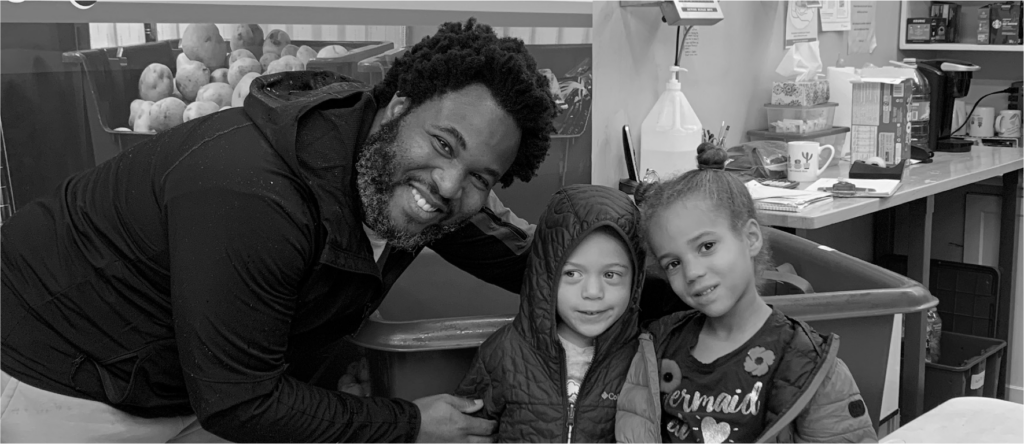
Our community has been the driving force that has allowed us to continue to feed our neighbours. In this photo, Desmond (4) and Madeline (6) collected 131 lbs. of food as part of their combined birthday celebration.
The Rise in Food Bank Usage
In 2022, almost every conversation at some point was punctuated with the question, “Is the Food Bank doing okay?” Understandably, people are concerned as we all watch today’s shifting financial climate. National inflation has led to a rise in food insecurity. Rising mortgage rates have led to unimaginable percentages of family incomes being dedicated to paying off homes before they can pay for basic amenities and food. All the while we continue to see the impact on our health systems, along with the social and economic results of the Covid-19 pandemic. But what does that mean for the Burlington Food Bank?
The increase we’ve seen in food bank usage from 2020 to 2022 is significant. We see that the number of unique individuals served has increased by 14% and the total number of visits has increased by 42% in the last two years. This is, unfortunately, a worrying sign of normalization in the rising use of food banks across Canada. This normalizing trend is reflected in the Feed Ontario Hunger Report 2022 (4) and Food Banks Canada HungerCount 2022 (5) —both released at the end of 2022. We will be referencing both of these documents throughout this section of data analysis, though we also encourage you to read both of these sources as they provide even greater insights on top of our own.
Unique Individuals Served
The number of unique individuals served (UIS) demonstrates how many clients are accessing the Food Bank each year. In 2019, 1,895 individuals accessed the Burlington Food Bank. That number increased in 2020 by 62% to 3,081 unique individuals because of the effects of the pandemic and emergency lockdowns.”. In 2021, to our surprise, this number remained level as we saw the same number of unique individuals that we had seen in 2020. We hoped that we would see a similar trend in 2022, but that wasn’t to be the case, as the UIS rose an additional 14% to 3,517 individual clients.
In addition to this rise in the UIS, the total number of visits has been growing steadily over the past four years. As you can see in FIGURE 1.1 (6), the graph shows us that the Food Bank saw the total number of visits from clients total 10,522 in 2019. In 2020, that number rose by 39% to 14,636, and then again in 2021 by 20% to 17,581 total visits. 2022 saw us break the 20,000-visit threshold and followed the trend with an 18% increase to a total of 20,420 visits.
In the Food Banks Canada HungerCount 2022 (8) report, we see the total number of visits measured over two distinct periods. These measurements in FIGURE 1.2 (9) show the percentage increase from 2021 to 2022 and then the percentage increase from 2019 to 2022. In terms of total visits in the first set of data, the Burlington Food Bank is shown to be in line with the comparative metrics in Ontario and Canada as a whole. The second set of data, however, shows a staggering increase of 94% in the total number of visits we see in that four-year window. When comparing this to Ontario (at 43%) and the whole of Canada (at 35%) we have to ask ourselves why Burlington saw such a massive increase in those four years and what can be done about it.
An Unusual Occurrence
The beginning of the summer of 2022 was stressful for the Burlington Food Bank. Typically around those summer months, we would see a drop-off in the number of donations. This was a usual occurrence and was offset each year because, alongside that drop-off, we would also see the number of people who were using the Food Bank decline as well. That was not the case in June of 2022, as we saw the anticipated dip become an unusual spike in the increase of total visits. As the summer continued, the numbers dropped a little but continued to stay high. You can see this trend reflected in FIGURE 1.3 (11). It was only thanks to the careful stewardship of the resources we had been given that we were able to buy what we needed to ensure that the quantity and quality of food we provided didn’t waiver. Despite the stress on our resources and staff, we were able to overcome those difficulties.
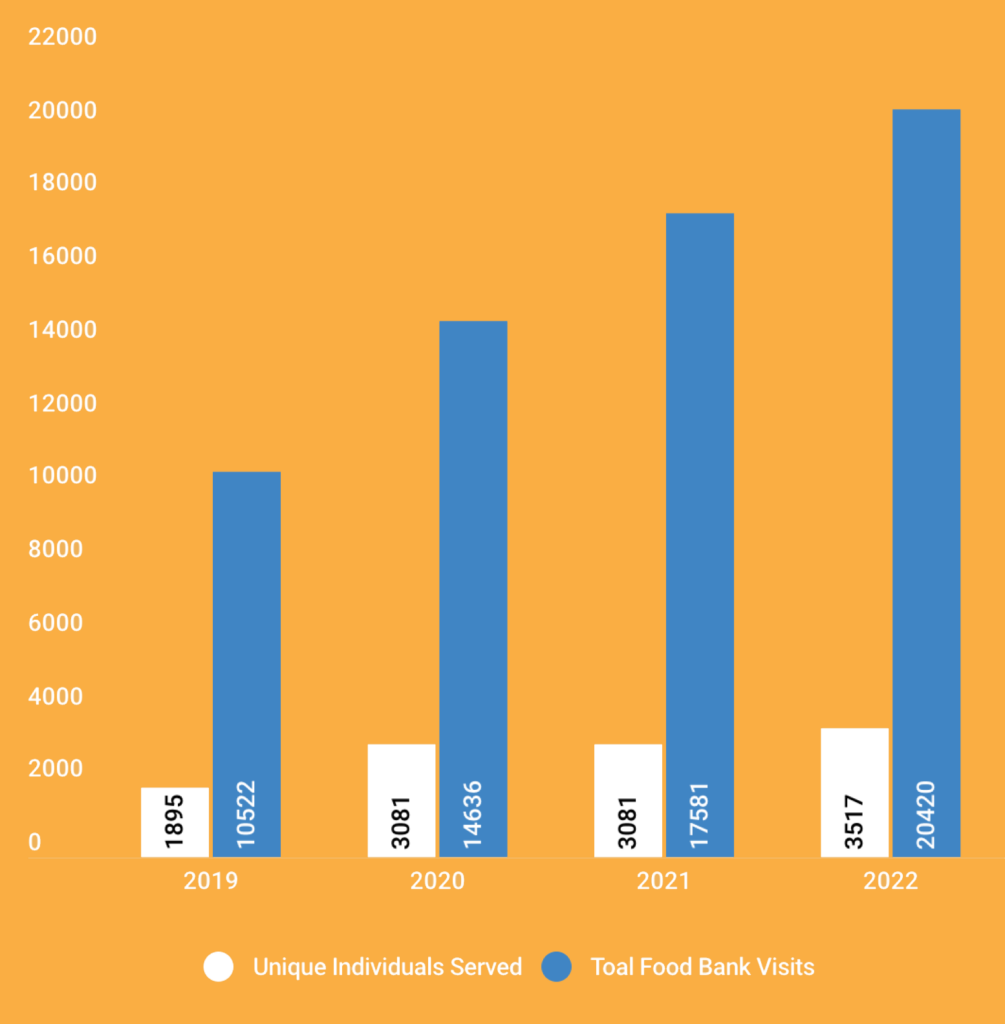
FIGURE 1.1 - GRAPH OF RISING UNIQUE INDIVIDUALS SERVED AND TOTAL NUMBER OF VISITS (7)
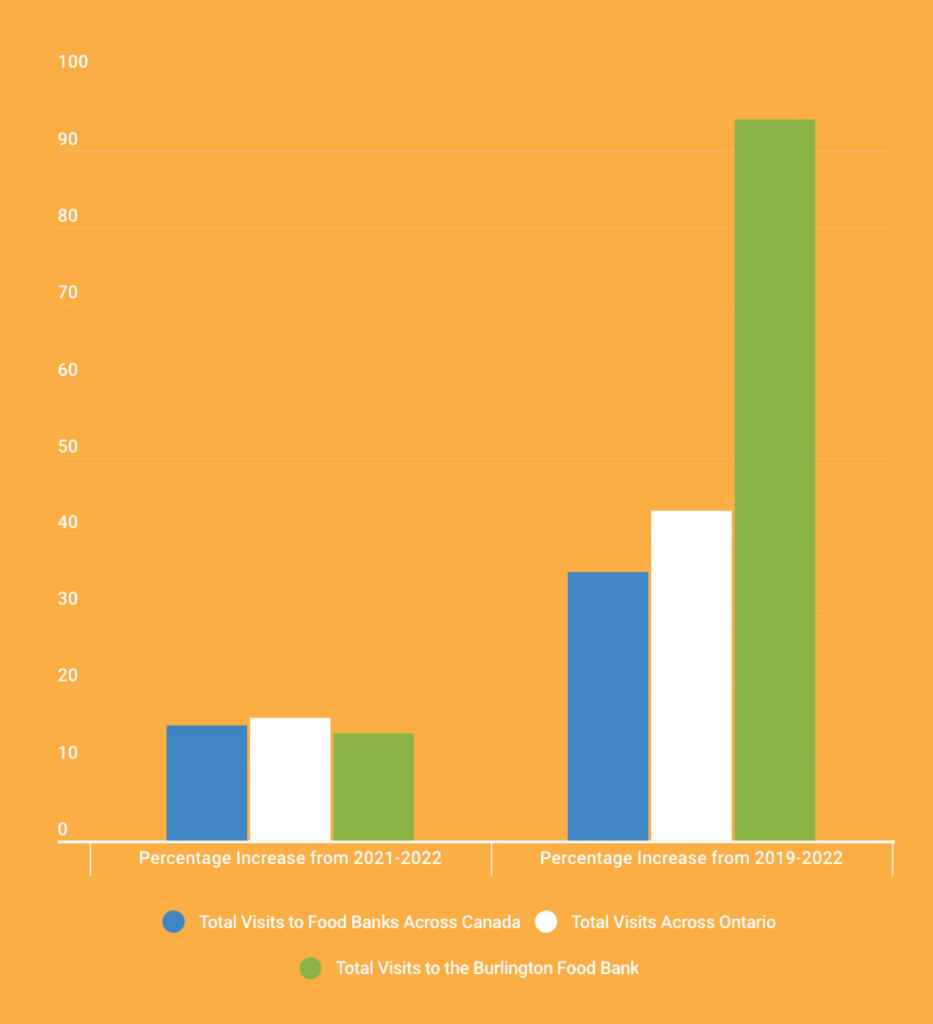
FIGURE 1.2 - GRAPH OF COMPARISON OF NUMBERS FROM FEED ONTARIO AND FOOD BANKS CANADA (10)
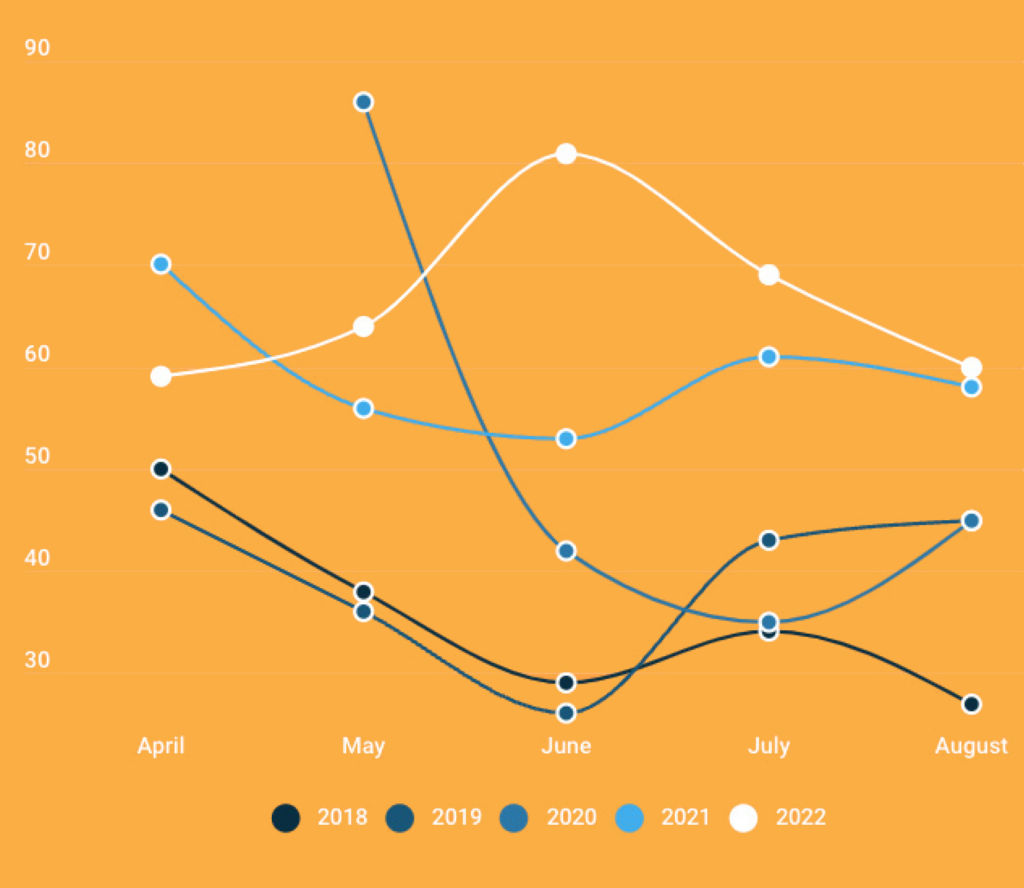
FIGURE 1.3 - Summer Months Burlington Food Bank Usage Graph (12)

Helen’s First Visit
A story of new hope
Helen came to the Burlington Food Bank after a great deal of deliberation. There had been so many things to consider before she could take that all-important step and ask for the help she needed. She wondered if she had done everything she could have done to make her finances stretch. And she agonized that she might be taking food from someone that might need it more. Most of all, she thought about how her husband, Ben, might feel about her visiting a food bank.
She had been working since she had left high school. Grocery stores, bakeries, small mom-and-pop shops; she had found a love for retail. In particular, she loved talking to others, asking them about their day, and getting to make their world just a little bit brighter with nothing more than a smile. When she turned 64, she was forced to retire when her job proved too much for her health. Ben had retired too, but continued to pay the bills with odd jobs and passion projects.
After Ben’s passing, Helen found herself on a fixed income — but her cost of living kept increasing. Food prices and rent were just too expensive and even after cancelling as many little extras as she could, she still couldn’t make ends meet. She found herself forced to choose between affording groceries and keeping her home.
“I didn’t know what to expect,” she says. “I was a little nervous, but everyone was so nice and helpful.”
To Helen’s surprise, the Food Bank provided more than enough food for her. She had expected to receive nothing but canned and dried food, but there were also healthy, fresh fruits and vegetables as well as frozen items that could last her the next few weeks. As she selected her cereal and cans, she talked with the staff and volunteers. She was so delighted that the Food Bank was there when she needed it.
Who is Using the Food Bank?
If you want to know who uses the Food Bank, just look at your neighbours. Over the years, we’ve found that Burlington is unique among the cities in the Greater Toronto and Hamilton Area. Most towns and cities have pockets of food insecurity or specific neighbourhoods that present as poorer or richer than the average. Burlington’s poverty, on the other hand, is well hidden and it’s found in every demographic. It doesn’t matter your age, ethnicity, or gender. Because of the ongoing financial instability, we need to start to recognize that hunger is an issue that can affect anyone in our community and we need to start to recognize that there should be no stigma attached to asking for help when you need it. While those using the Food Bank can come from all walks of life, some groups have been hit significantly harder in the last year.
An Increase in Seniors
We have seen a significant increase in terms of the unique number of seniors who have been using the Food Bank. In 2022, we saw a 312% increase compared to 2018. The largest increase in these numbers occurred during the pandemic, but those numbers have continued to increase over the last three years. You can see this trend reflected in FIGURE 1.4 (13).
Seniors are a group of clients whose income doesn’t change very often, but as we’ve seen over 2022, the rising cost of food and rent remain high and continue climbing. This has left many seniors forced to tap into resources that they hadn’t planned to use or look to sources of money that they may not have access to anymore.
On the positive side, this increase may also be because we started delivering from the Food Bank during the Pandemic. When deliveries started, we saw all kinds of people who didn’t have the means or the capability to access our Plains Road East location suddenly able to reach out to us. For those people who have always needed assistance but now no longer have that barrier stopping them, we’re thrilled. It’s because of this notable impact that we will continue to run our delivery system for as long as we can.
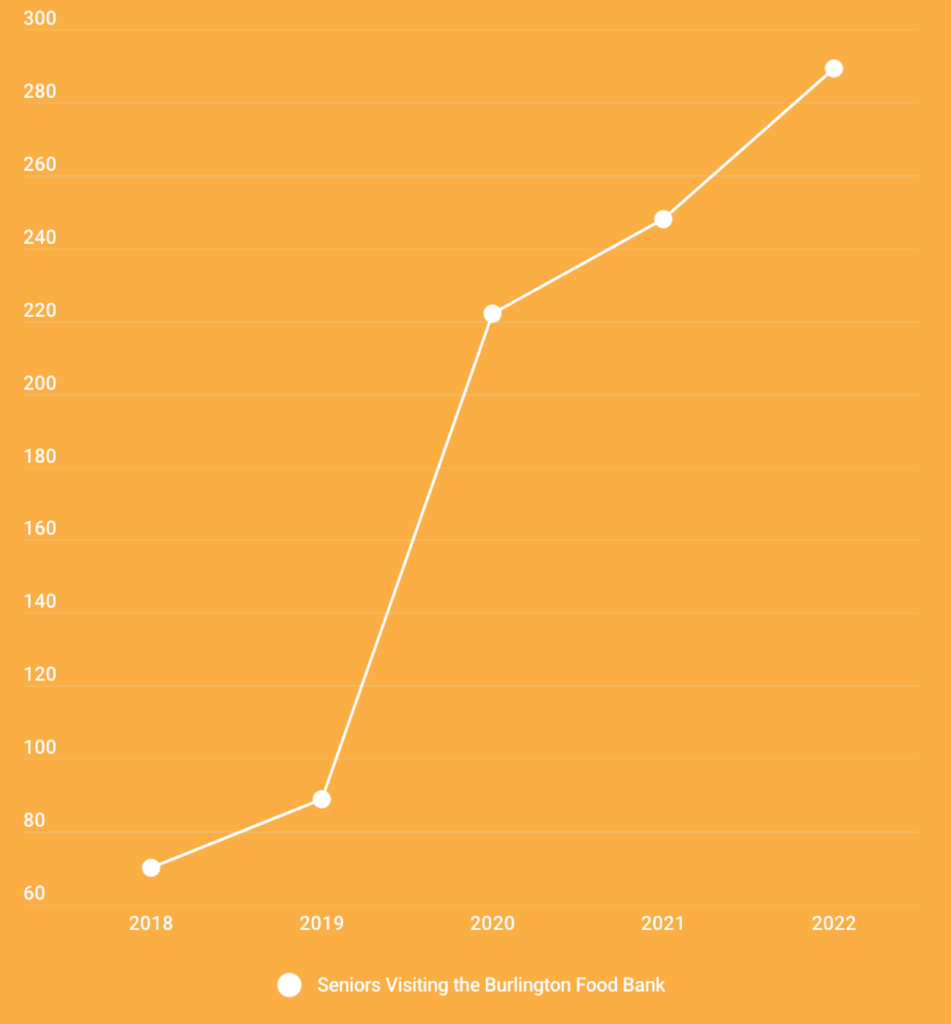
FIGURE 1.4 - GRAPH OF The rise in The number of seniors using the Burlington food bank (14)
New Canadians are Using the Food Bank for Longer
Another place we’ve seen a large change because of the inconsistency in the job market is in the longer-term use of the food bank by new Canadian immigrants. It’s not historically unusual to see those who have just moved to Canada need a little additional help as they establish themselves. Those who we meet through the Food Bank often come with a dream for a new life and they do everything they can to attain that dream. It used to be that a new family immigrating to Canada would come maybe once or twice to visit us and then we would never see them again because they had found meaningful work.
According to the Food Banks Canada HungerCount report, “1 in 7 people using a Food Bank are employed”. (15) With a greater shift in the market to a larger portion of individuals who work in Canada needing to secure two or even three jobs to make ends meet, it’s no wonder that meaningful employment for new immigrants is lacking.
These individuals can sometimes be those who have made plans to immigrate, but more and more we are seeing refugees requesting our assistance. Most recently, we have seen an increase in Ukrainian refugees accessing our support. It is important to understand that this observation is not meant to be a negative reflection on those new Canadians who request our help. But, ultimately, it is troubling that those who come to Canada seeking the safety and security they couldn’t find at home aren’t also finding the meaningful employment opportunities that they require to thrive and move forward here.
Children Served
Children 18 and under make up the largest group that we serve at the Burlington Food Bank. When we see children using the Food Bank we have to remember and understand that they are in the process of creating the foundational building blocks of who they are going to be. Those childhood and adolescent years form a large part of who they will be when they eventually make up the members of our community. This is why it is so important to make sure that hunger is not an issue for our kids. A lack of food can impact not just a child’s physical development but also their intellectual development, mental health, social development, and education.
If a family with children is struggling with food insecurity right now and those children are not eating well, their future begins to look a lot bleaker. It’s these concerns that drive us at the Food Bank to continue to support families that ask for our assistance. In 2022, we distributed school snacks to 4789 families with elementary-aged children under the age of 12. These school snacks include juice boxes, granola bars, and crackers, and are an incredible way to bring dignity to some of our most vulnerable clients. You can read Mary’s story on page 13 to discover how this program got its start.
We also understand that it’s not just the children in a family that hunger impacts. arents and caregivers are also impacted negatively by hunger, and that, in turn, impacts their children. We know that it is harder to think straight when we’re hungry. When we don’t take care of ourselves, we’re not the best person, let alone parent, that we could be. When a parent can stop worrying about where their next meal for their child is coming from, they have the opportunity to tackle other pressing problems like finding meaningful work or securing stable housing with confidence. We are proud that we can provide this kind of relief for our clients with children.
In 2022, we received a note from one of our clients that read: “I just wanted to drop a line to express my gratitude and tell you what a relief it is, as a mother, to not have to stress about where I’m going to get food for my child for their next meal.”
This, and notes like it, remind us at the Burlington Food Bank time and time again that we need to recognize that children are not able to look out for themselves. We must make sure that our children in Burlington are well-fed, and part of that is also making sure that their parents and caregivers are well-fed so that they are parenting the best they can.

Mary Gowan has been involved with the Burlington Food Bank as a volunteer, for more than ten years and sat on the board as vice chair for more than five years. She has used the incredible insight from her years as a teacher to champion innovations that have improved the Food Bank for the better.
Mary’s School Snacks
A story of historical change
Mary was a teacher before serving for more than 10 years on the board of the Burlington Food Bank. On rainy days, when her grade eight students were forced to stay inside while they ate their snacks, Mary would spend that time supervising them. But soon she noticed a handful of students who often didn’t bring a snack. She quickly discovered that this was due to food insecurity at home. Mary saw a problem and asked herself how it could be solved.
It wasn’t long before she came up with the notion of the snack box that sat at the front of her class. And with the snack box came a new rule: ‘no unopened food was to be thrown away’. Instead, the students were encouraged to take their unwanted items and place them into the snack box. The students began putting things in the box, but Mary noticed that not one of the students would take anything from the box.
One day, while the kids were working, she saw a big red apple. Walking past it she plucked it from the box asking, ‘does anyone want this?’ None of them answered. Mary took a bite. It didn’t take long before all the kids were taking food from the snack box. Even kids that weren’t part of her class. This small act of normalizing a solution to a food security issue made it acceptable. Every kid took what they needed. And so, the kids without snacks weren’t singled out. They found dignity instead.
When Mary joined the Burlington Food Bank Board of Directors, she saw that this wasn’t just a problem for the students in her school. It was her experience in her teaching career that led her to pioneer the School Snack Program, which is still an important part of feeding our neighbours to this day.
Why are People Using the Food Bank?
Job Security
When the minimum wage was raised in Ontario to $15.50, many thought that it was a real win for all those who were employed in minimum-wage jobs. While it’s true that the individuals who needed it were now earning more, at the same time, is a $15.50 minimum wage really a living wage?
We saw that with the increase in the Ontario minimum wage came the disappearance of a lot of full-time jobs. Companies were soon finding that it cost them too much in benefits and overtime on top of the mandatory pay increase. And it doesn’t just impact those who work minimum-wage jobs. The Feed Ontario Hunger report (16) states that “…education, credentials, and experience are no longer a guarantee that working professionals will be able to secure quality employment. This is further evident in a recent survey which showed that 22 percent of Canadian professionals are in precarious positions that do not provide steady income, pension, benefits, or sick pay.”
We all rely on access to quality jobs to build stability in our lives. Without a steady income or necessary additional benefits, ordinary people are more and more likely to be left with difficult decisions to make when they face unexpected bills and other emergencies.
The report goes on to say, (17) “…more low-income and minimum-wage workers faced a growing gap between the income that they were able to earn and the cost of their necessities each month. This is arguably reflected in food bank use data, which shows a 27 percent increase in the number of people with employment turning to food banks for assistance within two years of these policy changes. This trend has continued, with the proportion of people with employment accessing food banks increasing an additional 16 percent between 2020 and 2022.”
Feed Ontario shows in its report and FIGURE 1.5 (18) that the minimum wage across the Greater Toronto Area is an incredible 35% below the living wage. In comparison, according to livingwagehalton.com (19), the estimated Burlington living wage in 2021 was $20.75 per hour. In 2022 alone, we saw an inflation rate of 6.3%, which would have increased the estimated living wage to just over $22 per hour. All of a sudden, we’re seeing that a person has to work two or even three part-time jobs to take home the equivalent amount they saw with just one job before. In Burlington, with a 40% pay gap between the minimum wage and what you need to live, it’s no wonder that so many people in 2022 could not make ends meet. The math just doesn’t add up.
SIDENOTE: The living wage is calculated based on a weighted average of the various needs of a family of four, a single parent, and a single adult. Living wage includes shelter, food, clothing, medical expenses, childcare, transportation, recreation, and a modest vacation. The calculation excludes things like debt repayment, savings for retirement, savings for children’s future education, or homeownership.

FIGURE 1.5 - GRAPH OF Minimum wage compared to living wage for cities and towns across Ontario (20)

Our clients face tough choices. Often having to choose between housing and food. This reality is becoming all too common.

More and more we are seeing clients reaching out to us despite being employed.
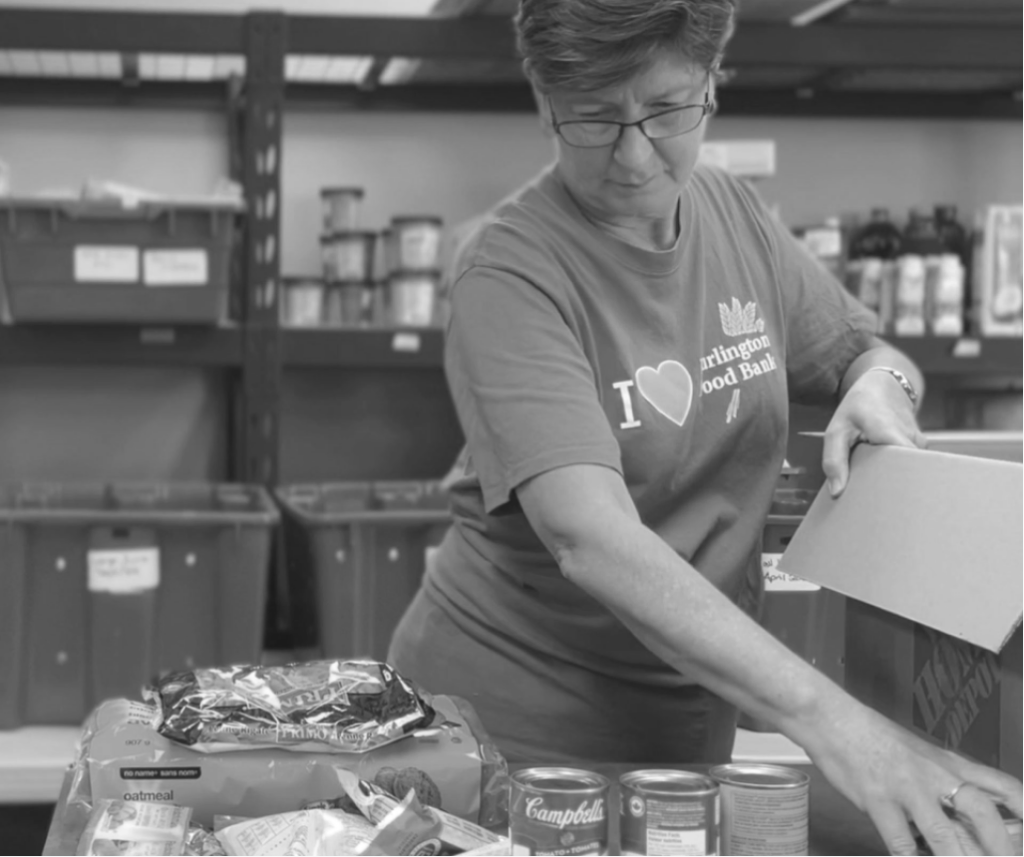
Our community shows that they care by collecting, packing and distributing food.
Housing and Rent
In addition to the inconsistency in the job market, we’ve also seen inflation hit the housing market hard. A lot of these mortgage increases have left many to make the difficult choice between paying what they owe on their home and being able to afford to buy food for their table. This is a choice that no one should be forced to make. According to the Feed Ontario, 2022 Hunger Report, “2 in 3 people who visited a food bank in Ontario were left with less than $100 after paying their monthly housing costs.” (21) As a fixed expense and non-negotiable cost, a lack of affordable housing is a key contributor to food insecurity.
Anecdotally, at the Food Bank, we recently had a delivery driver come back having just delivered food to a client. The driver remarked that when they got there it was a nice-looking condo, but when the client opened the door to receive their food they realized that this person had no furniture. This is something that we are continuing to see more and more as the risks of food insecurity grow. The outside of someone’s life looks so nice. They have a phone, a car, and a house, but underneath it all, they live in a place they can barely afford. And this reality is becoming more common. Food Bank clients exhibit for everyone else a life that is flourishing but unfortunately, it is nothing at all like their actual lived experience.
At the Burlington Food Bank, we understand that mortgage rates are going to continue to go up. It’s not something that any of us can control. We want people to know that if they’re in that situation and they need help, please know that it’s available. It’s, unfortunately, another one of those circumstances where there are a lot of people who won’t use the Food Bank when they need it because they convince themselves that there are poorer people with more need than they have. We want everyone to understand that the community cares about them. We see that life is sometimes difficult or overwhelming and that expenses happen that they weren’t planning on. So, if they need help, we’re here.
Social safety nets
The majority of people we see on a regular basis are trying hard to try to make it work. It’s a huge misconception to think that those who access the Food Bank may just be lazy or aren’t trying hard enough. The Feed Ontario 2022 Hunger Report cites “that almost 2 out of 3 people who access food banks are social assistance recipients, with 32.5 percent citing ODSP and 26 percent citing OW as their primary source of income.” (22) Anyone who has to rely on Ontario Works (OW) or the Ontario Disability Support Program (ODSP) as their major source of income must be working incredibly hard to stretch that amount of money so far. Most people would find it impossible.
It’s very rare that someone just isn’t budgeting well enough to make ends meet. Though it is not required to access our services, we do encourage new clients to share their financial information when they come to visit us. If a client shares that information, we try to point them in the right direction to get the resources and help they might need.
We’ve learned that we don’t need to be experts at everything. It’s incredible how many professional resources we have in our network. Skillful people who can help in all kinds of ways beyond gathering and distributing food. It might be budget counselling or credit counselling, or maybe someone to help find an affordable home. Whatever it is, we want to help our clients connect with them and get the support they need.

When Hard Work Is Not Enough
A story of help when it’s needed most
Alex is a certified electrician. He completed 840 hours of in-class training and 8,160 hours of on-the-job training to become registered in the trade in Ontario. It’s not easy work, but he enjoys his job and is part of his union. Before the pandemic he thought that he would never need a food bank.
Now Alex has found that the number of jobs available through his union has become increasingly scarce. Competition for regular work has become incredibly fierce. Time after time, Alex was left willing to work with a lack of opportunities. His brother stepped in, often buying him groceries to help make ends meet. It wasn’t long before Alex felt his line of ‘family credit’ was running low. His brother’s generosity was very welcome but he didn’t like feeling that his needs were putting pressure on their relationship. It was at that point that Alex came to the Burlington Food Bank seeking the help he needed.
“It was a difficult time for me,” Alex says. “I knew for a long time that I needed help but I wasn’t sure how to ask for it.”
At first, he debated if he were ‘poor enough’ to ask for help but after his first visit, he saw that he could get what he needed and there would be enough for others too. Alex knew that though he wouldn’t always need the Burlington Food Bank, it would always be here when he needed it.
What We Learned Since the Pandemic
On January 9, 2023, the Burlington Food Bank opened its doors to clients for the first time since the lockdown began in March 2020. Over the last two years, we had gone to a socially-distanced system of curbside pick-ups and home deliveries fulfilled by an incredible group of volunteers.
Up until that point, clients would come every three weeks to collect their groceries without needing to call ahead. When the pandemic began it was March, so the weather was starting to warm up. People would turn up at our front door looking for help. We never like seeing people lined up around the corner, but that was what was happening. Soon enough we were asking ourselves “is there a better way of doing this?” and so we figured out the delivery system.
Back in 2020, it was difficult to communicate with people about the shift to deliveries until they came to our door. Even throughout the summer, we were still getting the occasional person still showing up at the door. It made for a very slow rollout, but through word of mouth and with the help of some donated advertising space on bus shelters from Pattison we managed to promote the move to a new system. The bus shelter ads were a simple message: “If you need help, we’re here for you.” At that point, there wasn’t much more we needed to say. Every in-person food pick-up also contained a note that told our clients: “Here’s how to call next time, we’ll bring your food to you.”
We tweaked our systems almost every day. From one week to the next, volunteers would come in to help and the first question they would ask was “What has changed this week?” Sometimes we wouldn’t realize that we only changed something a week before. Things moved so fast that it felt like we had always done that thing in that way. We had a solid team, it was pretty amazing — but everything was reactionary.
We learned in that time to be open to conversations. When volunteers or clients would let us know that we could make an adjustment that would improve what we do, we needed to be willing to adjust. We did our best to make sure that there were no accessibility issues. If something was causing an issue, we would hope that those affected would help identify that for us so that we could overcome it. We have always had clients that couldn’t get to us, so we had to get to them. We recognized that there used to be a significant accessibility issue. The pandemic helped us to begin to fix that issue. Recognizing, identifying, and then making change is a skill we excelled at and we will continue to use that skill with each new challenge we face.
We’re Open Again!
There’s so much dignity that comes with picking food items yourself. There’s something about the ability to plan your meals that is so much better than someone selecting groceries for you. We also realize that we’re not just giving food to people — we’re providing a social safety net. At the Food Bank, there are people that our clients can converse with and enjoy social time together. They might be the only other people they see that week. There’s something to be said about seeing people’s eyes. You can get to know them a little more on a personal level and hopefully learn to see and address their needs a little bit more.
Even as we open our doors again, we will continue to make deliveries. Especially for those seniors who can’t get out all too often. The delivery model has removed barriers for several groups that might have had problems getting to the Food Bank in the past.
Capacity Building
Historically, the Burlington Food Bank served about 12 families a day. Now we serve somewhere between 30 to 35 families daily. We’ve seen a 150% increase and at the end of summer 2022, we found ourselves with only two full-time staff members. The only way we got through this difficult season was thanks to the incredible work of our volunteers, coordinated by our staff member, Diane Gris. It was Diane’s outstanding capability and hard work that meant that we could navigate those incredibly stretching months. Most of all, her interpersonal skills have encouraged great dedication that we continue to see from our volunteers. This effort and dedication from staff and volunteers show just how much our Burlington community cares.
To continue to grow in step with the increasing need in our community, however, we understand that we need the right staff in place to continue to build our capacity for the future. At the end of 2022, we hired two new staff onto our team. The first was Jon Williams, Marketing and Community Fundraising Manager, and the second was Tracy Wilkinson, Intake & Warehouse Assistant. Both of these hires have been instrumental in the next stages of our development as an organization.
We plan to continue hiring great staff to serve our clients and the community as we move into 2023. We need that support system in place with our extended hours, new programs and partnerships, and so many different projects going on throughout the year. It simply takes more people. After all, we’re built on the principle of people helping people. Most importantly, we want to make sure that the level of customer service doesn’t get lost. So you need people who are highly qualified and able to maintain that level and that’s what we now have.

Diane Gris
Intake & Volunteer Coordinator
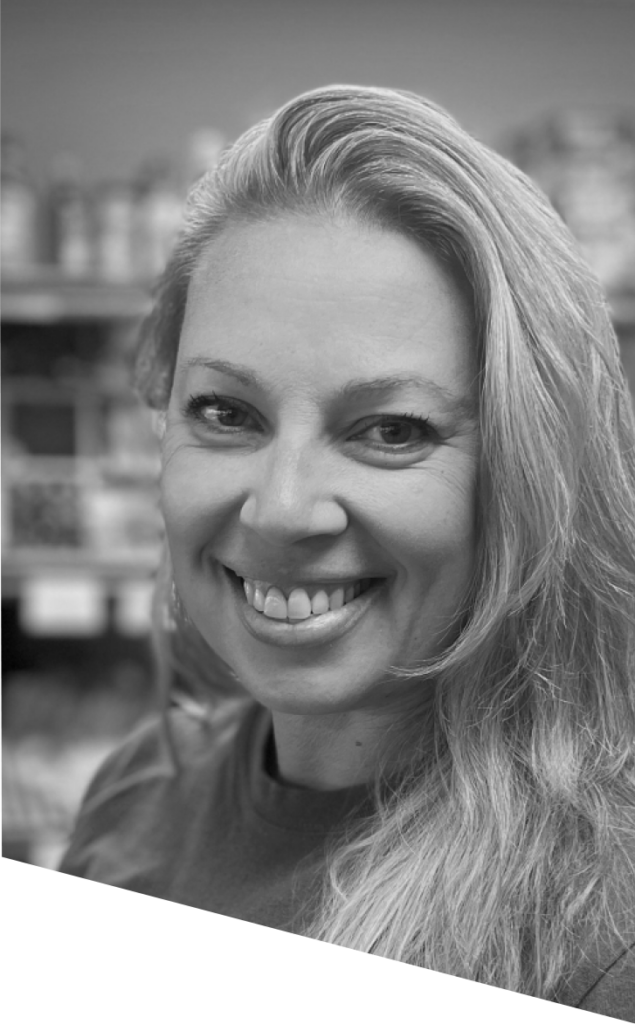
Tracy Wilkinson
Intake & Warehouse Assistant

Jon Williams
Marketing & Community Fundraising Manager
Our staff team has been growing in 2022. As part of our goal to increase or capacity to feed our hungry neighbours, Robin Bailey and Diane Gris were joined by Tracy Willkinson and Jon Williams.

At our Food Distribution Centre announcement, we were thrilled to be joined by representatives from the Region of Halton, Feed Ontario, the City of Burlington and the Town of Oakville.
The Future of Food Banking
On January 30, 2023, the Burlington Food Bank staff gathered in the parking lot of the unfinished Unit 5 building outside of 5280 Mainway, Burlington. With us stood our board, members of the press, and a delegation of officials that represented Burlington, Oakville, and the Region of Halton. Even though the weather had turned bitterly cold, there was an excitement that each person shared as Robin Bailey, Executive Director at the Burlington Food Bank, announced that this space was soon to be opened as a Food Distribution Centre.
Coming out of the pandemic, the food security network in Burlington had been forced to adapt and grow as a result of the influx of requests that all of the agencies across the city were now receiving. We were no different and so we adapted by reaching out to those organizations around us, forming new relationships and strengthening existing ones. In the face of adversity, we learned to cooperate and work together.
We had noticed a similar interaction happening in other regions. Cooperation among agencies grew into facilities that could nurture and provide for a whole regional network. New possibilities were right there at our fingertips. Opportunities to build and support the food security network in Burlington and even out into the Region of Halton. Someone just needed to step forward and make it happen. Not just for our clients, but for everyone in the community.
We’re seeing food insecurity grow and we know that just giving out more and more food from 1254 Plains Road East isn’t the answer. No, the only way forward is for everyone to begin to come together, for all the agencies, food cupboards, and pantries to be strengthened and encouraged by each other.
That is how the notion of the Food Distribution Centre was born. And thanks to the incredible generosity of our community, we have had the opportunity to cultivate that dream. To start thinking about what the best thing might be for hungry people all across Halton. We see this as an exciting opportunity to continue the Food Bank’s mission to ‘provide nutritious food to the hungry of our community in a dignified and timely manner’.
The Food Distribution Centre
The Mainway distribution facility is not a place where individuals will pick up food. Instead, it will be used to gather and store larger amounts of food than any agency in the Burlington network has been able to up to this point. From here, it will serve not only the Food Bank’s Plains Road East location, but will also extend our ability to help the wider network of food security solutions found across the City of Burlington and out into the Region of Halton.
It’s important to know that this isn’t the Burlington Food Bank building a franchise. We’re not opening a chain of Burlington Food Banks across the region. We probably could have done it that way, but our dream is much less self-serving. We want to celebrate and magnify the communities that have already been built throughout Halton. So many of our partners have already grown their communities well and our dream is to support them better.
This doesn’t mean that something new is completely out of the question. We also want to identify what we call ‘food deserts’. These are parts of the community where you have to travel a long way to get the support you need. But these most likely wouldn’t be new Burlington Food Banks either. Instead, we would identify public buildings and community organizations that are already in use to become partners with. It’s so important that we find places that are already easy to access and welcoming for those who need them. A place where they can get the same service, quality, and quantity of food that they already get from us, without having to travel to the west end of the city.
As of January 2022, this isn’t just a dream anymore. We now have the ability and the resources to help our food security network become more cohesive. We also bring our membership with Feed Ontario. Because of expanded partnerships and the larger space that the Food Distribution Centre will cultivate, we’ll be able to use that membership to access and distribute even more key resources to the network. In turn, this feeds into our allocations of dairy and eggs, which we can share throughout the Halton Region. Working together we can provide so much more support to everyone in Burlington and eventually out into the Region of Halton.
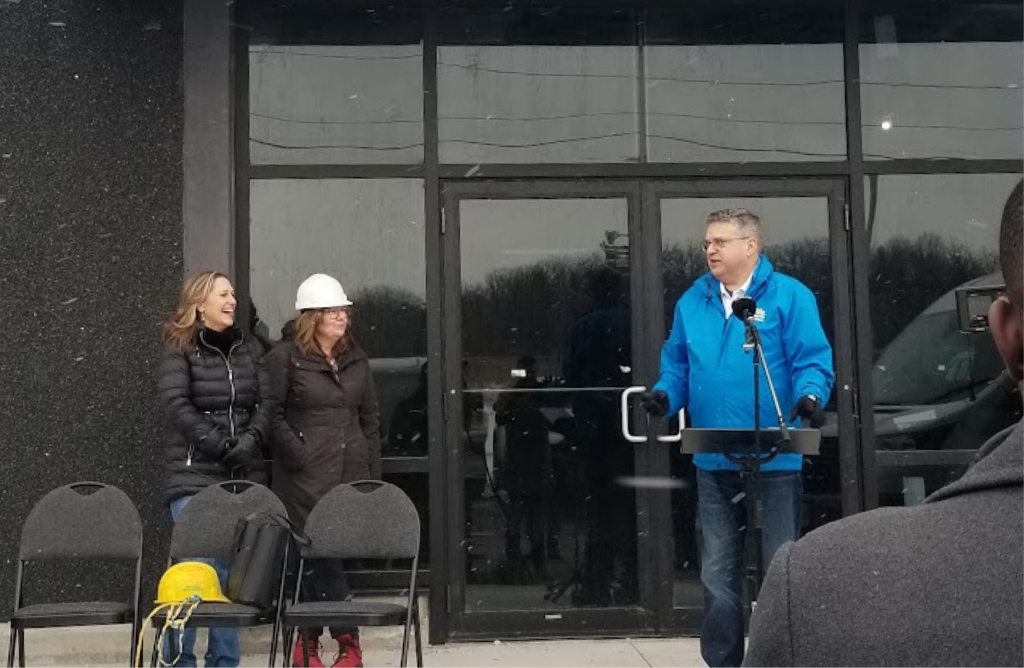
Food Bank volunteer Sean loves to involve his grandchildren when giving and teach them the importance of caring for our neighbours in need.
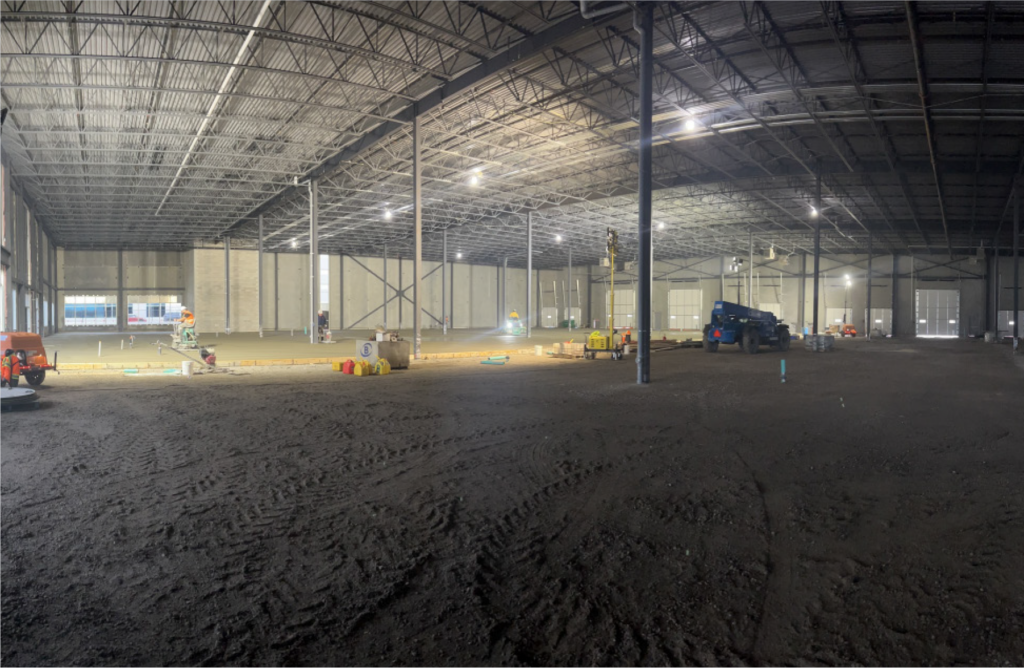
In September 2022, the Tim Hortons Smile Cookie campaign raised an incredible $89,733 to help feed our neighbours thanks to local Tim Hortons Owners and representatives from the Burlington Food Bank.
Conclusion
It’s not all Doom and Gloom
Too many people have defeatist attitudes. Yes, we’ve seen very worrying trends in food insecurity. Yes, some bad people take advantage of others. And yes, we’re still uncovering the impacts that the pandemic continues to have on our society. All of these are ongoing problems for our society. You can focus your attention on those things, but that’s not going to solve the problems that our community is facing. At Burlington Food Bank, we are going to strive to look for the positive in every situation that we can. So, allow us to reframe some of these problems in a more positive light.
All of the crises that we’ve faced over the past few years have allowed more people to reach out for help when they need it. Over the last three years, we have met first-time clients who have needed our help for a long time, but there were barriers keeping them from coming in. We have worked hard to make the necessary changes to remove those barriers.
As a community, we’ve helped so many people since 2020. We had the opportunity to give healthy and nutritious food to our clients a total of 52,637 times over the last three years. All of that food was only available because we have the generosity, support, and dedication of our Burlington community.
The pandemic taught us that together we can make a difference. We’ve taken those lessons learned and implemented them in ways that we didn’t think were possible four or five years ago. Our new Food Distribution Centre will create a stronger, more cohesive food security network and we can’t wait to see it in action.
What Can You Do?
The most important thing you can do is to educate yourself about the food security crisis we find ourselves in. Then, take that knowledge and share it with others. We need to make hunger a topic of conversation that we’re not afraid of. We shouldn’t fear asking for help. You may even have someone in your social circle who is in desperate need but has no idea of where to go or what to do. So having these conversations is critical to cultivating an accepting community.
You can also become an advocate for us. Letting other people know about the work we do and that we do it well. After all, it’s not just our staff that does the work, it’s a community effort. We want to recognize and celebrate our volunteers, our donors, and our community leaders. Those people who run food drives and sort donations are integral to what we do. The work that is achieved is so important for the health of the Burlington community as a whole.
Donations are always a big help. We are incredibly grateful anytime someone chooses to give to us. On the other hand, people don’t realize the impact that a monthly donation can make. A lot of our donors give a lump sum at the end of the year and that kind of donation is very much appreciated. But a monthly donation allows us to plan. It lets us know that we have enough monetary donations for those times when our physical food donations are running low. Giving a monthly gift that is just 10% of what you might give as an end-of-year gift means that you give 20% more than you would have in that lump sum, you may even find it easier on the budget to donate smaller amounts regularly. A monthly gift of $10 becomes $120 over the year. A monthly gift of $25 becomes $300 over the year. And a monthly gift of $50 becomes $600 over the year. That little bit of additional money can buy a lot of fruits, vegetables, and milk and help us keep operating.
We’re Here to Help When You Need Us
Hunger is already far more common than we think, and as we continue into 2023, it’s only going to become more prevalent. Sadly, food insecurity is becoming more and more commonplace as we hear all of the stories about the skyrocketing price of food on our supermarket shelves, or read about homeowners unable to pay mortgages or rent that only a year before was a manageable cost. We may listen to these tales of woe and dismiss them as ‘the new normal’, or try and find someone to pin the blame to. These stories and the flippant reactions to them are all too common in our social media news feeds.
There are a lot of people in Burlington who try to go without. They are forced to choose one necessity over the other — rather than coming to the Food Bank. But if we can encourage people to speak out about the times they have had to rely on the community, perhaps it would give others the courage to come to the Burlington Food Bank and ask for what they need. Normalizing the telling of these stories can only help to remove the stigma and perceived weakness that surrounds the act of asking for help in putting food on the table.
The future can be a little more hopeful when we work together. Yes, food insecurity might start to be viewed as commonplace but we hope that every person in our community can begin to normalize the solutions to these problems as well. At the moment, that solution looks like food banks. But we hope that the steps we take today, the innovations we create, and the important changes we make to the systems that we are a part of will pave the way to a future where we no longer need food banks.
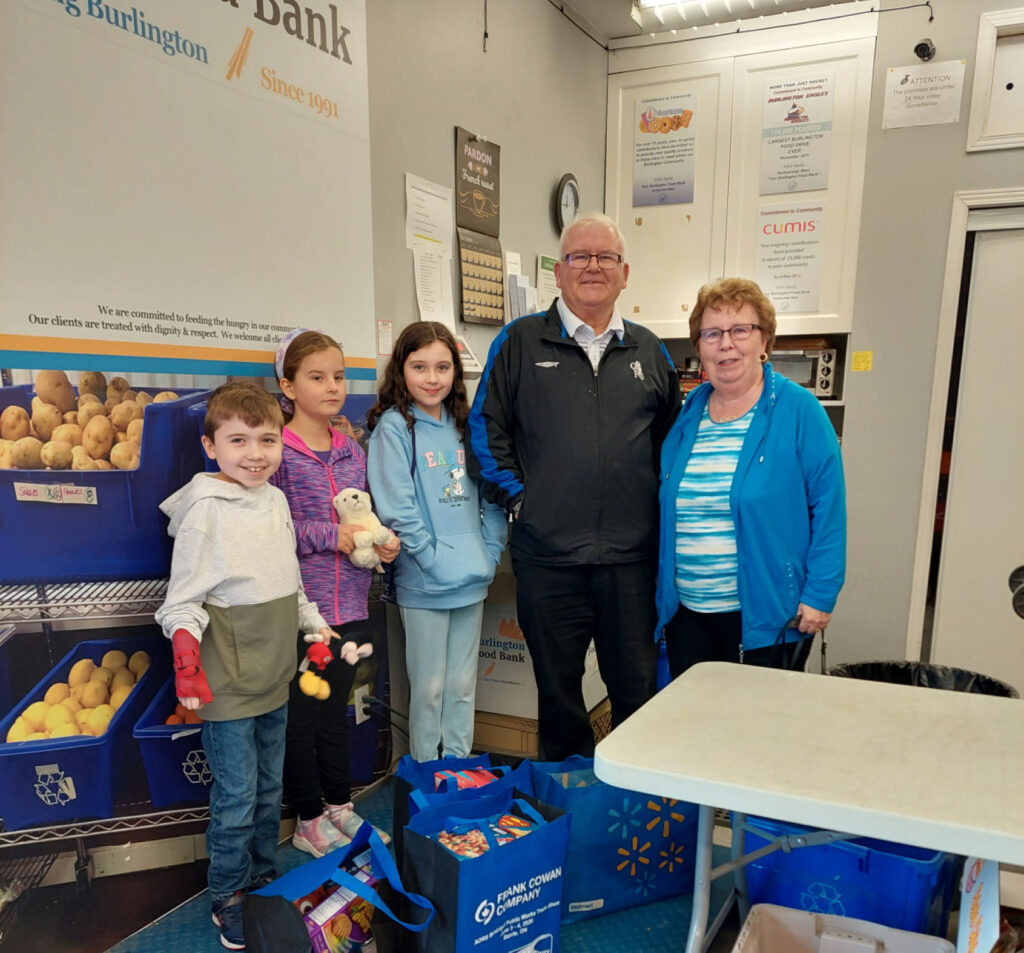
Food Bank volunteer Sean loves to involve his grandchildren when giving and teach them the importance of caring for our neighbours in need.
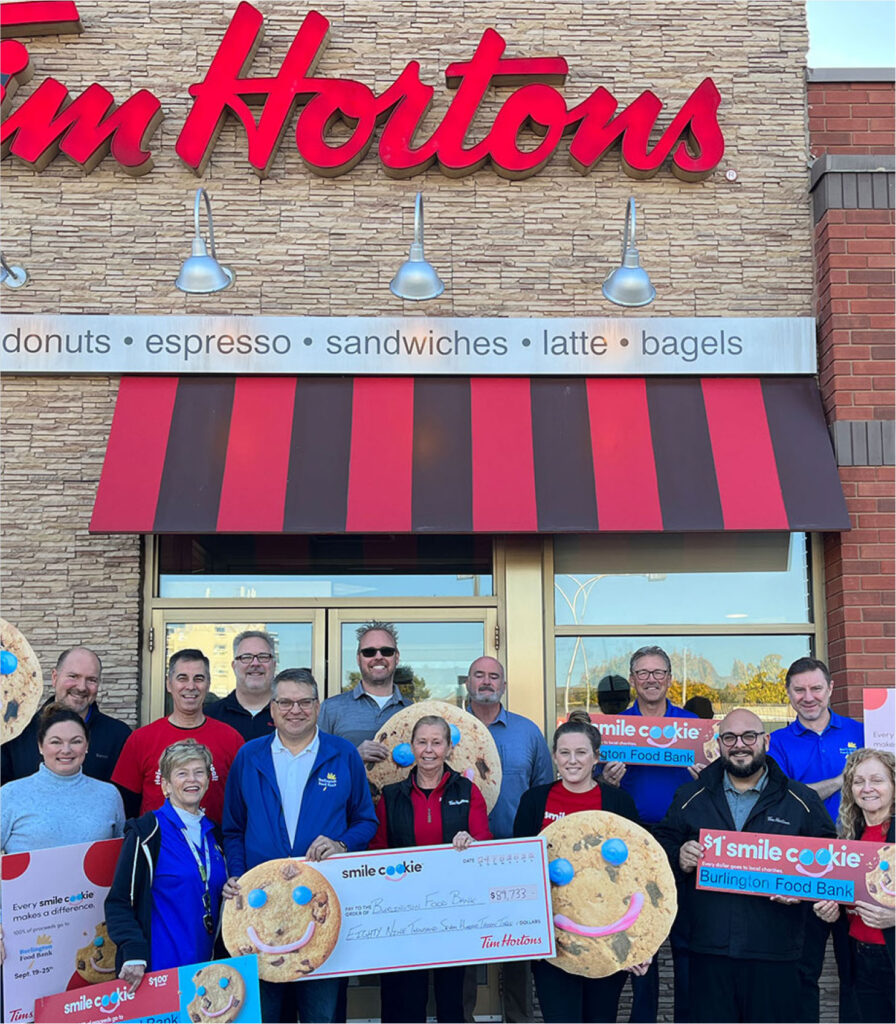
In September 2022, the Tim Hortons Smile Cookie campaign raised an incredible $89,733 to help feed our neighbours thanks to local Tim Hortons Owners and representatives from the Burlington Food Bank.
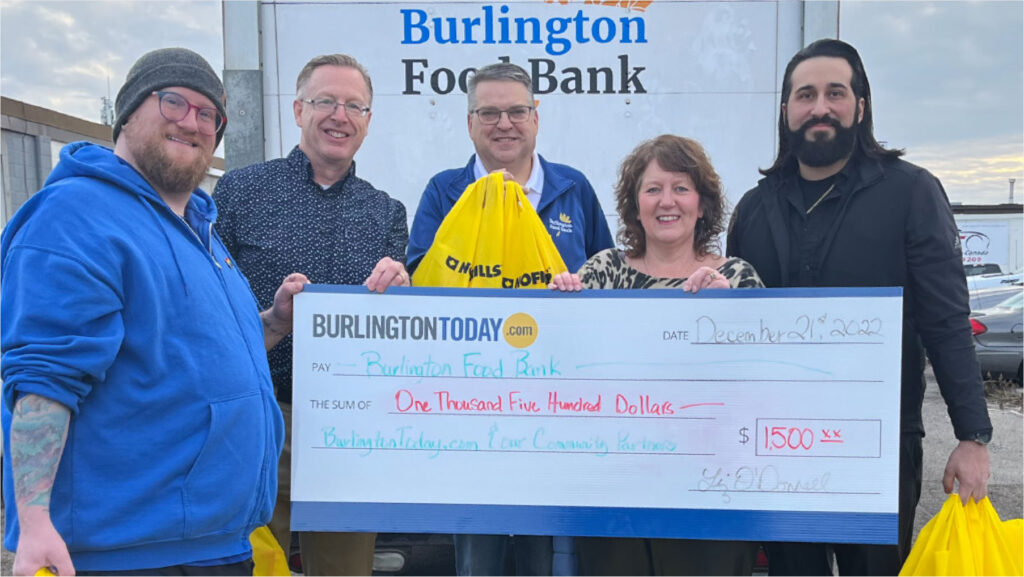
In December 2022, BurlingtonToday.com and Michael’s No Frills helped to raise food and funds when we needed it most.
Special Thanks to...
WhiteEagle for gifting the Burlington Food Bank with her wealth of wisdom and knowledge and to Eathan O’Grady for lending their incredible energy. Thank you both for helping to shape our Land Acknowledgement.
Jennifer Arnold for providing her keen eye and editing this report.
Feed Ontario for producing their Hunger Report 2022 resource.
Food Banks Canada for producing their HungerCount 2022 resource.
Our Partner Agencies who continue to work with us to build and strengthen the incredible food security network across Burlington and beyond:
- Appleby United Church
- Burloak Our Community Cares
- Compass Point Bible Church
- Compassion Society of Halton
- Good Shepherd Hamilton
- Grace United Church
- Kerr Street Mission
- Gore Park Community Outreach
- Parkview Church
- Reach Out Centre for Kids
- Rock Hub
- Open doors at St. Christopher’s
- St. Luke’s Anglican Church
- The Salvation Army
- Warwick Our Community Cares
- Wellington Square United Church
Our Volunteers for all that you do to collect, sort, pack, distribute much-needed food to our neighbours when they need it.
Our Board for lending their expertise to our organization.
Our Burlington Community for continuing to help feed our neighbours in 2022. We are truly shaped by a community that cares and we couldn’t do it without you.
References
(1), (4)
Feed Ontario (2022) Hunger Report 2022
(2), (5) , (8), (9), (10), (15)
Food Banks Canada (2022) HungerCount 2022
(3), (6), (7), (11), (12), (13), (14)
Burlington Food Bank (2022) Statistics and graph data collected from Burlington Food Bank records
(16)
Feed Ontario (2022) Hunger Report 2022, Page 12
(17), (18), (20)
Feed Ontario (2022) Hunger Report 2022, Page 14
(19)
Living Wage Halton (2021) LivingWageHalton.ca



